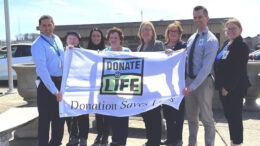WILMINGTON, N.C. (AP) — A deteriorating Matthew was stripped of hurricane status Sunday morning and began making its slow exit to the sea after unloading more than a foot of rain on North Carolina that flooded homes and businesses as far as 100 miles inland.
What will go down as one of the most potent hurricanes on record in the U.S. was blamed for at least 10 deaths in the U.S. and more than 500 in Haiti.
Dozens of people — including a woman and her small child — had to be rescued from their cars as life-threatening flash floods surprised many in North Carolina.
As night fell Saturday, authorities warned people to stay off the roads until the storm had passed, and the full extent of the damage was not expected to become clear until daylight.
The unofficial rainfall totals were staggering: 18 inches in Wilmington, 14 inches in Fayetteville and 8 inches in Raleigh.
“This is a very, very serious and deadly storm,” Gov. Pat McCrory said.
Before daybreak Sunday, the hurricane was downgraded to a post-tropical cyclone. As of 8 a.m. EDT, the storm was centered about 60 miles southeast of Cape Hatteras, North Carolina, moving out to sea. It still had hurricane-force winds of 75 mph.
Forecasters said North Carolina and Virginia could get even more rain and warned of the danger of life-threatening flooding through Monday night.
While the crisis was far from over in North Carolina, other places to the South began getting back to normal, with millions relieved that the storm wasn’t the catastrophe that many had been bracing for.
In many places along the Southeast coast, the damage consisted mostly of flooded streets, blown-down signs and awnings, flattened trees and power outages.
As the skies cleared on Saturday, people started cleaning up, reopening their businesses or hitting the beach. The power started coming back on. And all three major theme parks in Orlando, Florida, including Walt Disney World, were up and running.
Along Daytona Beach’s main drag, the Silver Diner had all of its shiny metal siding ripped off the front and sides, leaving only a wood frame exposed. Next door, the window of a souvenir shop had been blown out and the roof and ceiling torn through, leaving pink insulation dangling.
David Beasley, president of Insurance Recovery Inc., surveyed the damage and said that although it looked bad, the main strip was hit harder by Hurricane Charley and Hurricane Frances in 2004.
“This is not much compared to those two,” he said.
On Saturday, Matthew sideswiped two of the South’s oldest and most historic cities — Savannah, Georgia, and Charleston, South Carolina — and also brought torrential rain and stiff wind to places like Myrtle Beach, South Carolina.
After pounding North Carolina and drenching parts of Virginia, it was expected to veer out to sea, lose steam and loop back around toward the Bahamas and Florida, too feeble to cause any trouble.
For nearly its entire run up the coast from Florida, Matthew hung just far enough offshore that communities did not feel the full force of its winds.
Its storm center, or eye, finally blew ashore just north of Charleston on Saturday, but only briefly. And by that time, Matthew was just barely a hurricane, with winds of just 75 mph.
Matthew’s winds were howling at a terrifying 145 mph when the hurricane struck Haiti, where five days later the full extent of the tragedy was not yet known because some devastated areas were still unreachable.
In Brunswick County, North Carolina, about 100 hotel guests had to be taken by bus to a shelter because the main walls of the Comfort Inn Suites were on the verge of collapse. And dramatic video showed Fayetteville police rescuing a woman and her small child from their car as rising waters swallowed it.
An estimated 2 million people in the Southeast were ordered to evacuate their homes as Matthew closed in. By hugging the coast, the storm pretty much behaved as forecasters predicted. A shift of just 20 or 30 miles could have meant widespread devastation.
“People got incredibly lucky,” Colorado State University meteorology professor Phil Klotzbach. “It was a super close call.”
While Matthew’s wind speed had dropped considerably by the time it hit the Southeast coast, the storm will still go down as one of the most potent hurricanes on record, based on such factors as wind energy and longevity, and as one of the most long-lived major hurricanes, too.
It was a major hurricane — that is, with winds of at least 110 mph — for just over seven days.
Hundreds of thousands of people lost power in North Carolina, three-quarters of a million in South Carolina, 250,000 in Georgia and about 1 million in Florida.
Four deaths were blamed on the storm in Florida, three in Georgia and three in North Carolina. The deaths included an elderly Florida couple who died from carbon monoxide fumes while running a generator in their garage and two women who were killed when trees fell on a home and a camper.
Property data firm CoreLogic projected the storm would cause $4 billion to $6 billion in insured losses on home and commercial properties. That compares with Hurricane Katrina’s $40 billion and Superstorm Sandy’s $20 billion.








































